个人理财英文版第二章培训资料
个人理财英文版第二章

• Insolvency:
N–eIntabWilityotrotphay debts when due – Liabilities far exceed assets
2-14
Sample Balance Sheet
2-15
Ways to Increase Net Worth
Documents re: purchase and sale of real estate Copies of tax returns and supporting data
Indefinitely
As long as you own them Indefinitely
7 years minimum 10 years better
RATIO
Calculation
Interpretation
Debt Ratio
Liabilities divided by net worth
Low debt is best
Curent Ratio Liquidity Ratio
Liquid assets divided by current liabilties
Money Management Troubles & Debt
Getting out of debt:
2-5
An Organized Personal Financial Records System
Provides a basis for:
• Handling daily business affairs, such as bill paying • Planning and measuring financial
公司理财英文版第二版教学设计 (2)
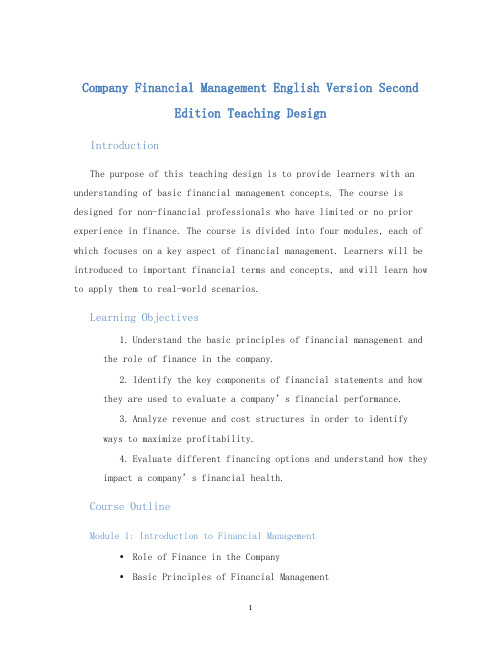
Company Financial Management English Version SecondEdition Teaching DesignIntroductionThe purpose of this teaching design is to provide learners with an understanding of basic financial management concepts. The course is designed for non-financial professionals who have limited or no prior experience in finance. The course is divided into four modules, each of which focuses on a key aspect of financial management. Learners will be introduced to important financial terms and concepts, and will learn how to apply them to real-world scenarios.Learning Objectives1.Understand the basic principles of financial management andthe role of finance in the company.2.Identify the key components of financial statements and howthey are used to evaluate a company’s financial performance.3.Analyze revenue and cost structures in order to identifyways to maximize profitability.4.Evaluate different financing options and understand how theyimpact a company’s financial health.Course OutlineModule 1: Introduction to Financial Management•Role of Finance in the Company•Basic Principles of Financial ManagementModule 2: Financial Statements•Balance Sheet•Income Statement•Cash Flow StatementModule 3: Profitability Analysis•Revenue Streams•Cost Structures•Break-Even AnalysisModule 4: Financing Options•Equity Financing•Debt Financing•Capital StructuringTeaching MethodologyThis course will primarily be delivered through a combination of lectures, case studies, and group discussions. Learners will be given supplemental reading materials and will be expected to actively participate in class discussions.AssessmentStudents will be assessed on their understanding of key concepts through the completion of assignments, quizzes, and a final exam. The final exam will be comprehensive and will cover material from all four modules.ConclusionAt the end of this course, learners will have a basic understanding of financial management and the role of finance in the company. They will be able to analyze financial statements, evaluate profitability, and understand different financing options. These skills will enable learners to make informed business decisions and contribute to their company’s financial success.。
个人理财英文作文答案

个人理财英文作文答案下载温馨提示:该文档是我店铺精心编制而成,希望大家下载以后,能够帮助大家解决实际的问题。
文档下载后可定制随意修改,请根据实际需要进行相应的调整和使用,谢谢!并且,本店铺为大家提供各种各样类型的实用资料,如教育随笔、日记赏析、句子摘抄、古诗大全、经典美文、话题作文、工作总结、词语解析、文案摘录、其他资料等等,如想了解不同资料格式和写法,敬请关注!Download tips: This document is carefully compiled by theeditor. I hope that after you download them,they can help yousolve practical problems. The document can be customized andmodified after downloading,please adjust and use it according toactual needs, thank you!In addition, our shop provides you with various types ofpractical materials,such as educational essays, diaryappreciation,sentence excerpts,ancient poems,classic articles,topic composition,work summary,word parsing,copyexcerpts,other materials and so on,want to know different data formats andwriting methods,please pay attention!I need to save some money. For example, I can cut down on eating out and shopping.It's important to have a budget. That way I know where my money is going.Investing can be a good idea. But I have to learn more about it first.Sometimes I think about buying a lottery ticket. Maybe I'll get lucky.Credit cards can be handy, but I have to be careful not to overspend.I should review my financial situation regularly. See if I'm on the right track.。
个人理财英文版第二章

Benefits
1. Recap your current financial position in relation to the value of items you own and amounts you owe
2-11
Balance Sheet
A financial statement that reports what an individual or family owns and owes as of a specific date:
• ቤተ መጻሕፍቲ ባይዱlso called:
–Net worth statement –Statement of financial position
4. Connect money management activities with saving for personal financial goals
2-2
Objective 1
Identify the Main Components of Wise Money Management
• Money management = day-to-day financial activities necessary to manage current personal economic resources, while working toward long-term financial security
How much of earnings goes to sevice debt; less than 20% recommended
财务管理培训课程(英文版)
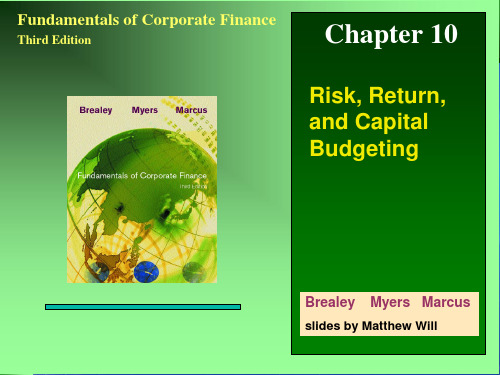
When the market was up 1%, Turbo average % change was +0.8%
When the market was down 1%, Turbo average % change was -0.8%
The average change of 1.6 % (-0.8 to 0.8) divided by the 2% (-1.0 to 1.0) change in the market produces a beta of 0.8.
E(RM ) R f E(RA ) E(RM )
M
( AM
2 M
)
/
M
10- 21
Derivation of CAPM
簡化上式:
E(RA) Rf
E(RM ) Rf
AM
2 M
In market model:
SML
RA A ARM A
A
AM
2 M
E(RA ) Rf E(RM ) Rf A
Measuring Beta Portfolio Betas CAPM and Expected Return Security Market Line Capital Budgeting and Project Risk
10- 3
Measuring Market Risk
Market Portfolio - Portfolio of all assets in the economy. In practice a broad stock market index, such as the S&P Composite, is used to represent the market.
公司理财英文版第二章
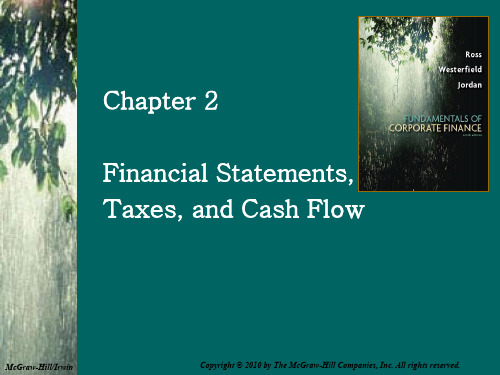
US Corporation Income Statement – Table 2.2
Insert new Table 2.2 here (US Corp Income Statement)
2-19
Hale Waihona Puke Income Statement Analysis
• There are three things to keep in mind when analyzing an income statement:
2-13
• Which one of the following is included in a firm's market value but yet is excluded from the firm's accounting value? A. real estate investment B. good reputation of the company C. equipment owned by the firm D. money due from a customer E. an item held by the firm for future sale
• Which one of the following accounts is the most liquid? A. inventory B. building C. accounts receivable D. equipment E. land
• Which one of the following represents the most liquid asset? A. $100 account receivable that is discounted and collected for $96 today B. $100 of inventory which is sold today on credit for $103 C. $100 of inventory which is discounted and sold for $97 cash today D. $100 of inventory that is sold today for $100 cash E. $100 accounts receivable that will be collected in full next week
个人理财英语复习课程
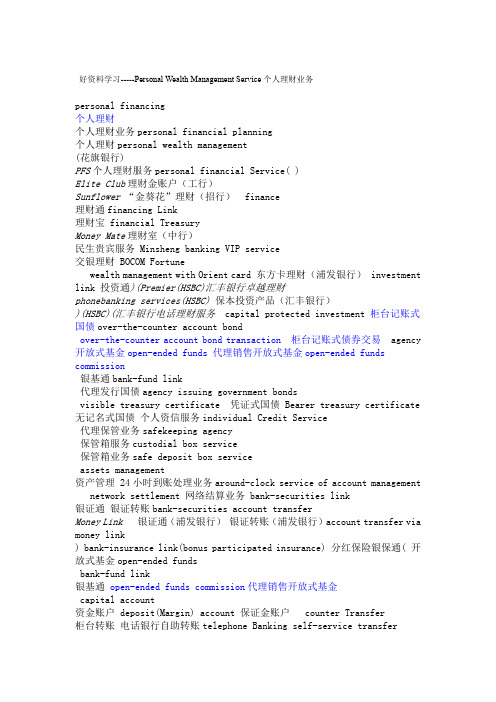
好资料学习-----Personal Wealth Management Service个人理财业务personal financing个人理财个人理财业务personal financial planning个人理财personal wealth management(花旗银行)PFS个人理财服务personal financial Service( )Elite Club理财金账户(工行)Sunflower“金葵花”理财(招行) finance理财通financing Link理财宝 financial TreasuryMoney Mate理财室(中行)民生贵宾服务 Minsheng banking VIP service交银理财 BOCOM Fortunewealth management with Orient card 东方卡理财(浦发银行) investment link 投资通)(Premier(HSBC)汇丰银行卓越理财phonebanking services(HSBC)保本投资产品(汇丰银行))(HSBC)(汇丰银行电话理财服务 capital protected investment 柜台记账式国债over-the-counter account bondover-the-counter account bond transaction柜台记账式债券交易 agency 开放式基金open-ended funds代理销售开放式基金open-ended funds commission银基通bank-fund link代理发行国债agency issuing government bondsvisible treasury certificate 凭证式国债 Bearer treasury certificate 无记名式国债个人资信服务individual Credit Service代理保管业务safekeeping agency保管箱服务custodial box service保管箱业务safe deposit box serviceassets management资产管理 24小时到账处理业务around-clock service of account management network settlement 网络结算业务 bank-securities link银证通银证转账bank-securities account transferMoney Link 银证通(浦发银行)银证转账(浦发银行)account transfer via money link) bank-insurance link(bonus participated insurance) 分红保险银保通( 开放式基金open-ended fundsbank-fund link银基通open-ended funds commission代理销售开放式基金capital account资金账户 deposit(Margin) account 保证金账户 counter Transfer柜台转账电话银行自助转账telephone Banking self-service transferservice更多精品文档.好资料学习-----a letter of entrustment for transfer 转账委托书委托转账代缴费entrusting transfer and deduction股东磁卡shareholders' magnetic card网络结算业务network settlement国内支付结算业务domestic payment settlement service养老基金old-age pension fund社会保险基金social security fund债券基金bond fund投资基金 investment fund封闭式基金 close-ended fund开放式基金open-ended fundSavings Deposit储蓄存款业务savings deposit活期储蓄存款 demand deposit(current deposit)活期储蓄存款 current deposit passbook活期存折 current checkbook deposit活期支票 time or demand optional deposit定活两便存款 call deposit通知存款 time deposit(term deposit)定期存款 large sum fixed deposit大额定期存款 general fixed deposit普通定期存款 floating time rate deposit定期浮息选择存款 lump-sum deposit and withdrawal整存整取 time deposit of lump-sum deposit and withdrawal整存整取定期储蓄 time deposits of lump-sum depositing and lump-sum整存整取定期存款 withdrawal零存整取 installment fixed deposits零存整取定期储蓄 time deposit of small savings for lump-sum withdrawal 存本取息 interest withdrawal for a principal deposited存本取息定期储蓄 peincipal-receiving and interest withdrawing time deposit整存零取定期储蓄 time saving big money and small drawing定活两便存款 savings / time optional depositsseven-day notice deposit 七天通知存款个人结算账户personal settlement account储蓄账户) (汇丰银行) avings account s(HSBC定期存款账户f ixed deposit account(HSBC) (汇丰银行) renminbi account(HSBC)人民币账户(汇丰银行) children account(HSBC)儿童账户(汇丰银行) statement savings account(HSBC)结单储蓄账户(汇丰银interest bearing savings account(HSBC)行) interest bearing chequeing account(HSBC)生息储蓄账户(汇丰银advance withdrawal and loss-reporting business 行)deposits by correspondence更多精品文档.好资料学习-----生息支票账户(汇丰银deposit collections in different places 行)personal checks提前支取与挂失业务deposit certificate loss reporting通信存款loss reporting for personal checks储蓄存款异地托收savings certificate个人支票personal call deposit储蓄存款挂失interbank deposit and withdrawal个人支票挂失education deposit定期存单个人通知存款通存通兑教育储蓄存款挂失业务procedures of loss reporting存单挂失deposit certificate loss reporting临时挂失 interim loss reporting活期一本通 current All-In-One passbookfixed All-In-One passbook 定期一本通 multiple function debit card 多功能借记卡)汇丰银行Deposit Plus(HSBC)(双利存款Personal Consumer Credit个人消费信贷housing mortgage loan住房抵押贷款个人商业用房贷款individual business house loan房屋装修贷款house refurbishing loan.个人住房贷款individual housing loans自营性住房贷款housing loans on own account委托住房贷款housing loans on authorizationindividual combined housing loans 个人住房组合贷款CITIC Happy Family 中信家家乐汽车消费贷款auto loansloan for refurbishing house 家居装修贷款大额耐用消费品贷款consumer durables loan个人存单质押贷款personal loan secured by CDs/treasury bonds个人消费信贷individual consumption loan小额信用消费贷款petty consumer credit个人信用贷款individual unsecured loanconsumption credit for individual clients 个人消费信贷业务 individualconsumption loan 个人消费信贷) secured loan抵押放款担保放款( small amount private loans 小额贷款 individual auto loan 个人汽车消费贷款个人综合消费贷款 individual comprehensive consumer loanindividual large-denomination durable commodities loan 个人大额耐用消费品贷款更多精品文档.-----好资料学习 personal pledge loan个人质押贷款 travel and vacation loans 旅游度假贷款网上个人质押贷款online personal pledge loan insurance certificate pledge loan 保单质押贷款 deposit certificate pledge loan 存单质押贷款 certificates of deposit(CDs)大额存单 individual comprehensive consumer loan个人综合消费贷款 individual large-denomination durable commodities loan 个人大额耐用消费品贷款 state educational loan国家助学贷款 commercial educational loan 商业助学贷款 overseas study loan 留学贷款 educational loans教育助学贷款Foreign Exchange for Corporate公司外汇业务forex deposit for enterprise单位外汇存款业务活期对公外汇存款current forex deposit for enterprise 定期对公外汇存款time foreign fxchange deposit for enterprise通知对公外汇存款forex deposit for enterprise call外汇贷款业务forex credit外汇流动资金贷款forex working capital loanforex temporary loans 外汇临时流动资金贷款外汇短期流动资金贷款forex short-term loans forex medium-term loans 外汇中期流动资金贷款外汇流动资金循环贷款forex revolving loansforex loans with repayment in Installments 外汇整贷零偿 forex fixed asset loan外汇固定资产贷款 forex fixed asset investment外汇固定资产投资贷款 forex business development and expansion 外汇开发扩建贷款 forex technical innovation 外汇技改贷款 forex fixed asset acquisition外汇固定资产收购贷款International Finance国际融资业务外汇兼并收购贷款forex merger&acquisition loan项目融资project financeBOT)build, operate, transfer 建设经营转让(BT)build, transfer(建设转让 export buyer's credit出口买方信贷 syndicated loan银团贷款 on-lending project finance 外汇转贷款项目融资国际商业贷款融资international commercial loanimport buyer's credit进口买方信贷融资 foreign government loan外国政府贷款融资更多精品文档.学习-----好资料foreign government mixed loan外国政府混合贷款融资国际金融组织贷款融资loan from international financial organizations 外汇转贷款forex transferred loan特色融资业务 f inancing business of features票据贴现bills discount授信额度credit line统一大授信w orldwide credit出口卖方信贷export seller's credit融资租赁finance lease应收账款收购 purchase of the accounts receivable对外劳务承包贷款 external labor service contract loan一路通 distribution passport创业宝 start-up winner国际融资及担保i nternational financing and guarantee business信托业务trust services境外发债融资international debt offering外汇担保业务foreign exchange guarantee借款担保guarantee for loan投标担保tender guarantee履约担保performance bondadvanced payment guarantee 预付款退款担保付款担保payment guarantee验货付款保函verification payment guaranteetechnical verification payment guarantee 技术交易验收付款保函延期付款担保deferred payment guaranteelease guarantee租赁担保 import bills for collection 进口代收 export bills for collection 出口托收出口托收买单purchasing collection bills打包放款(信用证项下)packing loan under L/C转让信用证transferable L/Cnegotiating export bills 议付出口信用证单据 discounting bills (银行承兑)汇票贴现 secured lading担保提货开立保函opening letter of guaranteeforeign exchange payment and clearing service外汇清算业务 settlement clearance for foreign exchange pusiness 外汇业务清算 banking facility授信 foreign exchange rate risks cover 外汇保值避险 guarantee and attestation担保和见证 inter-bank foreign currency borrowings and lendings 金融机构间外汇拆借 asset portfolio management 理财策划 offshore bankingbusiness 离岸金融业务 trade financing贸易融资更多精品文档.好资料学习-----综合授信 general banking facilities 打包放款 Packing Credit进口押汇 import bills purchase出口押汇 export(0utward) bill purchase外币票据贴现 foreign currency bill discount买入外币票据 foreign exchange bills purchase票据贴现 bills discountingForfaiting福费廷(包买票据)Factoring保理业务非贸易融资 non-trade finance银行卡业务Bank Card牡丹信用卡 peony credit card牡丹国际卡 peony international card牡丹灵通卡 peony MoneyLink card牡丹智能卡peony IC(Smart) card牡丹专用卡peony proprietary card牡丹彩照卡peony photo card牡丹联名卡 peony co-branding cardLong龙卡 card储蓄卡savings card借记卡 debit card生肖卡animal card转账卡account transfer card储值卡 pre-paid consumption card专用卡 special-purpose card联名卡(认同卡)co-branded cardGreat Wall长城信用卡 credit cardGreat Wall长城国际卡 international cardGreat Wall长城人民币信用卡 credit card in RMB 太平洋卡pacific card金卡gold card普通卡ordinary card金葵花卡The World's Sunflower发展卡development cardMinsheng民生卡 card东方卡 Orient card真情卡(Lady card 广发银行)维萨卡Visa card万事达卡Master card大莱卡 Diner's card运通卡 American Express card百万卡(日本) Million card卡(日本)JCB cardJCB更多精品文档.好资料学习-----发达卡(香港) Federal cardTerms of Post and Title岗位职务词汇董事会,理事会 board of directors董事长 chairman of the board董事长 chair of board of directors董事长chief executive officer董事director总裁,常务董事managing director代理行长authorized officer中国事务部经理兼主管 manager and head of China desk总经理 general manager(GM)总监 director general总稽核chief controller副总经理 deputy general manager(DGM)首席执行官 chief executive officer(CEO)首席财务总监chief financial officer(CFO)首席市场总监chief market officer(CMO)总经理top manager经理,主任 manager财务经理,财务处(科)长 finance director财务经理 financial manager会计主任,总会计师,财务处长 chief accountantchief cashier 出纳主任 chief clerk 主任办事员 head clerk首席办事员部门主任head of departmenthead teller出纳主任 chief accountant 总会计,会计主任 chief of finance 财务主任sales director 营业副经理;销售处(科)长 sales manager 销售经理directing staff 领导人员最高管理层top management中层管理middle management基层管理lower managementmanager of bank 银行经理人管理人员managerial staff高级职员officer, official财务顾问financial adviserfinancial accountant 财务会计员 financial administrator 财务主管人financial executive财务主管更多精品文档.好资料学习-----审计人员auditing officers主管会计;审计员controller主管会计师accountant in charge会计师,会计员accountant顾问consultant业务顾问management consultant经理人的代理managing agent助理会计师assistant accountant协理,副总经理,副总裁assistant general managerassistant manager 副理,协理 managing partner 办事员 administrative staff 管理人员,行政人员 office staff 办公室职员操作人员operation staff簿记员accounting clerkbank clerk 银行职员 office clerk办事员统计员statistical clerk出纳员pay clerkstaff 职员办事员clerk出纳员cashier出纳员teller顾客,客户customer顾客,客户clientIntermediary Business(1)中间业务汇兑业务remittance services国内汇兑domestic remittance代理汇兑remittance agency汇款直通车remittance express普通汇款 commom remittance加急汇款 urgent remittance票汇(汇票汇款remittance by draft )汇款cash remittance银行本票bank promissory note(bank check)支票check支票簿check Book代理业务agency services基金代理业务fund agency serviceBank-fund Link银基通Bank-futures Link银期通FortuneLink财富通更多精品文档.学习-----好资料bond agency service债券代理业务债券结算代理bonds settlement agency保险代理业务insurance agency service代理理财financing agency代理保管safekeeping agency代理收付collection and payment agency代理结算settlement agency代发工资(业务)salary payment agency(payroll agency service)代发工资(养老金)业务 wages(old-aged pension) distribution agency代理公用事业收费 public utility fee levying agency代理发行国债 issuing government bonds agencycommission collection of telephone fee代收电话费业务Unicom commission collection of telephone fee for 代收联通话费业务 commission collection of electricity charge 代收电费业务commission collection of insurance premium 代收保险费 payment through telephone banking 电话银行缴费 payment through mobile phone banking 手机银行缴费代收付业务network payment settlement agency网上支付结算代理agency collection and paymentcommission payment on consignment 委托缴费 payment in cash现金缴费缴费业务charge withholding service缴费通fee collection expresscommission security business 代理证券业务 agency securities fund clearing 代理证券资金清算 commission tax withholding 代理税收业务代理保险业务commission insurance代签银行汇票agency signing of the banker's billforward settlement期货结算业务 client service center 客户服务中心 customer servicehotline 客户服务热线 bearer treasury certificate 无记名式国债 visible treasury certificate凭证式国债固定面额无记名式国债bearer treasury certificate with fixed denomination 支付凭证 proof of payment(payment vouchers) 转账委托书 a letter of entrustment for transfer 代收代缴费 agency collection and payment代收代扣agency collection and deductionpublic utility Feeentrusting transfer and deduction 公用事业费 agency issuing government bonds委托转账代交费foreign exchange trading agencyautomated transferdeposit(margin) account代理发行国债更多精品文档.学习-----好资料代理外币买卖自动转账保证金账户bill consultancy票据查询 real-time funds transferring 实时资金汇划 counter transfer 柜台转账结算业务 settlement business国内结算业务 domestic settlement service 托收汇票托收承付 draft for collection委托收款 collection and acception 网上结算commission reception 网上购物on-line Settlement 代理证券资金清算on-line Shopping代理收付业务securities and capital settlement agency 客户条形码自动查询commission collection and payment agency 支付结算业务代理client bar code automatic inquiry system 期货结算业务payment and settlement agencyforward settlementnotes clearing票据交换 charged bond trading on the counter 柜台记账式债券交易treasury bills 国库券 treasury bonds长期国债 book-entry treasury bill 凭证式国债 visible treasury certificate 凭证式国债 investment banking 投资银行业务商人银行业务merchant banking咨询性金融业务consultancy-specific financial service基金托管funds trusteeshipcash-based settlement 现金清算 paper-based settlement票据清算 electronic-based settlement 电子清算 transferring settlement 转账结算 accounting settlement business会计结算业务更多精品文档.。
公司理财原版英文课件Chap020
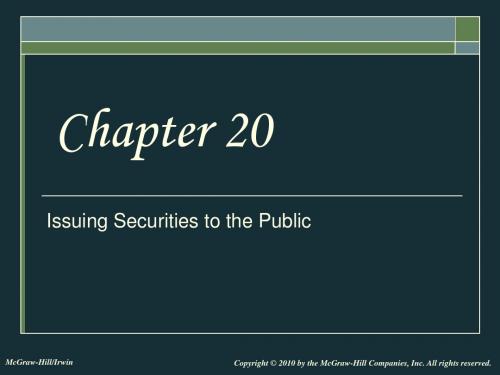
There are two methods for selecting an underwriter
Competitive Negotiated
20-9
Firm Commitment Underwriting
The issuing firm sells the entire issue to the underwriting syndicate. The syndicate then resells the issue to the public. The underwriter makes money on the spread between the price paid to the issuer and the price received from investors when the stock is sold. The syndicate bears the risk of not being able to sell the entire issue for more than the cost. This is the most common type of underwriting in the United States.
英文版罗斯公司理财习题答案Chap002
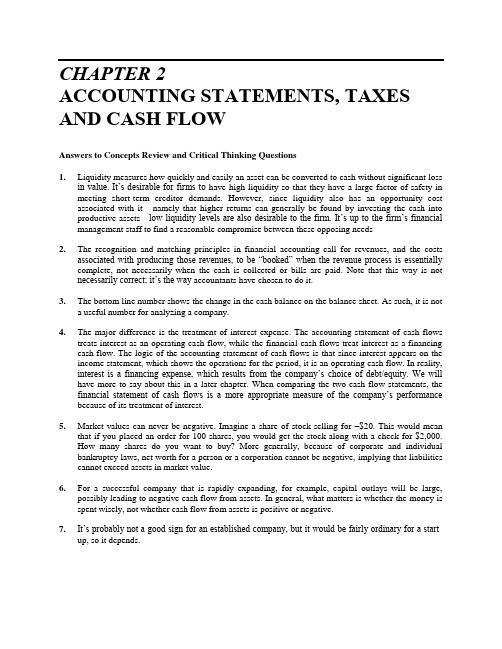
CHAPTER 2ACCOUNTING STATEMENTS, TAXES AND CASH FLOWAnswers to Concepts Review and Critical Thinking Questions1.Liquidity measures how quickly and easily an asset can be converted to cash without significant lossin value. It’s desirable for firms to have high liquidity so that they have a large factor of safety in meeting short-term creditor demands. However, since liquidity also has an opportunity cost associated with it - namely that higher returns can generally be found by investing the cash into productive assets - low liquidity levels are also desirable to the firm. It’s up to the firm’s financial management staff to find a reasonable compromise between these opposing needs2.The recognition and matching principles in financial accounting call for revenues, and the costsassociated with producing those revenues, to be “booked” when the revenue process is essentially complete, not necessarily when the cash is collected or bills are paid. Note that this way is not necessarily correct; it’s the way accountants have chosen to do it.3.The bottom line number shows the change in the cash balance on the balance sheet. As such, it is nota useful number for analyzing a company.4. The major difference is the treatment of interest expense. The accounting statement of cash flowstreats interest as an operating cash flow, while the financial cash flows treat interest as a financing cash flow. The logic of the accounting statement of cash flows is that since interest appears on the income statement, which shows the operations for the period, it is an operating cash flow. In reality, interest is a financing expense, which results from the company’s choice of debt/equity. We will have more to say about this in a later chapter. When comparing the two cash flow statements, the financial statement of cash flows is a more appropriate measure of the company’s performance because of its treatment of interest.5.Market values can never be negative. Imagine a share of stock selling for –$20. This would meanthat if you placed an order for 100 shares, you would get the stock along with a check for $2,000.How many shares do you want to buy? More generally, because of corporate and individual bankruptcy laws, net worth for a person or a corporation cannot be negative, implying that liabilities cannot exceed assets in market value.6.For a successful company that is rapidly expanding, for example, capital outlays will be large,possibly leading to negative cash flow from assets. In general, what matters is whether the money is spent wisely, not whether cash flow from assets is positive or negative.7.It’s probably not a good sign for an established company, but it would be fairly ordinary for a start-up, so it depends.8.For example, if a company were to become more efficient in inventory management, the amount ofinventory needed would decline. The same might be true if it becomes better at collecting its receivables. In general, anything that leads to a decline in ending NWC relative to beginning would have this effect. Negative net capital spending would mean more long-lived assets were liquidated than purchased.9.If a company raises more money from selling stock than it pays in dividends in a particular period,its cash flow to stockholders will be negative. If a company borrows more than it pays in interest and principal, its cash flow to creditors will be negative.10.The adjustments discussed were purely accounting changes; they had no cash flow or market valueconsequences unless the new accounting information caused stockholders to revalue the derivatives. Solutions to Questions and ProblemsNOTE: All end-of-chapter problems were solved using a spreadsheet. Many problems require multiple steps. Due to space and readability constraints, when these intermediate steps are included in this solutions manual, rounding may appear to have occurred. However, the final answer for each problem is found without rounding during any step in the problem.Basic1.To find owner’s equity, we must construct a balance sheet as follows:Balance SheetCA $5,000 CL $4,500NFA 23,000 LTD 13,000OE ??TA $28,000 TL & OE $28,000We know that total liabilities and owner’s equity (TL & OE) must equal total assets of $28,000. We also know that TL & OE is equal to current liabilities plus long-term debt plus owner’s equity, so owner’s equity is:O E = $28,000 –13,000 – 4,500 = $10,500N WC = CA – CL = $5,000 – 4,500 = $5002. The income statement for the company is:Income StatementSales S/.527,000Costs 280,000Depreciation 38,000EBIT S/.209,000Interest 15,000EBT S/.194,000Taxes (35%) 67,900Net income S/.126,100One equation for net income is:Net income = Dividends + Addition to retained earningsRearranging, we get:Addition to retained earnings = Net income – DividendsAddition to retained earnings = S/.126,100 – 48,000Addition to retained earnings = S/.78,1003.To find the book value of current assets, we use: NWC = CA – CL. Rearranging to solve for currentassets, we get:CA = NWC + CL = $900K + 2.2M = $3.1MThe market value of current assets and fixed assets is given, so:Book value CA = $3.1M Market value CA = $2.8MBook value NFA = $4.0M Market value NFA = $3.2MBook value assets = $3.1M + 4.0M = $7.1M Market value assets = $2.8M + 3.2M = $6.0M 4.Taxes = 0.15(€50K) + 0.25(€25K) + 0.34(€25K) + 0.39(€273K – 100K)Taxes = €89,720The average tax rate is the total tax paid divided by net income, so:Average tax rate = €89,720 / €273,000Average tax rate = 32.86%.The marginal tax rate is the tax rate on the next €1 of earnings, so the marginal tax rate = 39%.5.To calculate OCF, we first need the income statement:Income StatementSales 元13,500Costs 5,400Depreciation 1,200EBIT 元6,900Interest 680Taxable income 元6,220Taxes (35%) 2,177Net income 元4,043OCF = EBIT + Depreciation – TaxesOCF = 元6,900 + 1,200 – 2,177OCF = 元5,923 capital spending = NFA end– NFA beg + DepreciationNet capital spending = £4,700,000 – 4,200,000 + 925,000 Net capital spending = £1,425,0007.The long-term debt account will increase by $8 million, the amount of the new long-term debt issue.Since the company sold 10 million new shares of stock with a $1 par value, the common stock account will increase by $10 million. The capital surplus account will increase by $16 million, the value of the new stock sold above its par value. Since the company had a net income of $7 million, and paid $4 million in dividends, the addition to retained earnings was $3 million, which will increase the accumulated retained earnings account. So, the new long-term debt and stockholders’ equity portion of the balance sheet will be:Long-term debt $ 68,000,000Total long-term debt $ 68,000,000Shareholders equityPreferred stock $ 18,000,000Common stock ($1 par value) 35,000,000Accumulated retained earnings 92,000,000Capital surplus 65,000,000Total equity $ 210,000,000Total Liabilities & Equity $ 278,000,0008.Cash flow to creditors = Interest paid – Net new borrowingCash flow to creditors = €340,000 – (LTD end– LTD beg)Cash flow to creditors = €340,000 – (€3,100,000 – 2,800,000)Cash flow to creditors = €340,000 – 300,000Cash flow to creditors = €40,0009. Cash flow to stockholders = Dividends paid – Net new equityCash flow to stockholders = €600,000 – [(Common end + APIS end) – (Common beg + APIS beg)]Cash flow to stockholders = €600,000 – [(€855,000 + 7,600,000) – (€820,000 + 6,800,000)]Cash flow to stockholders = €600,000 – (€7,620,000 – 8,455,000)Cash flow to stockholders = –€235,000Note, APIS is the additional paid-in surplus.10. Cash flow from assets = Cash flow to creditors + Cash flow to stockholders= €40,000 – 235,000= –€195,000Cash flow from assets = –€195,000 = OCF – Change in NWC – Net capital spending= OCF – (–€165,000) – 760,000= –€195,000Operating cash flow = –€195,000 – 165,000 + 760,000= €400,000Intermediate11. a.The accounting statement of cash flows explains the change in cash during the year. Theaccounting statement of cash flows will be:Statement of cash flowsOperationsNet income ZW$125Depreciation 75Changes in other current assets (25)Total cash flow from operations ZW$175Investing activitiesAcquisition of fixed assets ZW$(175)Total cash flow from investing activities ZW$(175)Financing activitiesProceeds of long-term debt ZW$90Current liabilities 10Dividends (65)Total cash flow from financing activities ZW$35Change in cash (on balance sheet) ZW$35b.Change in NWC = NWC end– NWC beg= (CA end– CL end) – (CA beg– CL beg)= [(ZW$45 + 145) – 70] – [(ZW$10 + 120) – 60)= ZW$120 – 70= ZW$50c.To find the cash flow generated by the firm’s assets, we need the operating cash flow, and thecapital spending. So, calculating each of these, we find:Operating cash flowNet income ZW$125Depreciation 75Operating cash flow ZW$200Note that we can calculate OCF in this manner since there are no taxes.Capital spendingEnding fixed assets ZW$250Beginning fixed assets (150)Depreciation 75Capital spending ZW$175Now we can calculate the cash flow generated by the firm’s assets, which is:Cash flow from assetsOperating cash flow ZW$200Capital spending (175)Change in NWC (50)Cash flow from assets ZW$(25)Notice that the accounting statement of cash flows shows a positive cash flow, but the financial cash flows show a negative cash flow. The cash flow generated by the firm’s assets is a better number for analyzing the firm’s performance.12.With the information provided, the cash flows from the firm are the capital spending and the changein net working capital, so:Cash flows from the firmCapital spending $(3,000)Additions to NWC (1,000)Cash flows from the firm $(4,000)And the cash flows to the investors of the firm are:Cash flows to investors of the firmSale of short-term debt $(7,000)Sale of long-term debt (18,000)Sale of common stock (2,000)Dividends paid 23,000Cash flows to investors of the firm $(4,000)13. a. The interest expense for the company is the amount of debt times the interest rate on the debt.So, the income statement for the company is:Income StatementSales £1,000,000Cost of goods sold 300,000Selling costs 200,000Depreciation 100,000EBIT £400,000Interest 100,000Taxable income £300,000Taxes (35%) 105,000Net income £195,000b. And the operating cash flow is:OCF = EBIT + Depreciation – TaxesOCF = £400,000 + 100,000 – 105,000OCF = £395,00014.To find the OCF, we first calculate net income.Income StatementSales Au$145,000Costs 86,000Depreciation 7,000Other expenses 4,900EBIT Au$47,100Interest 15,000Taxable income Au$32,100Taxes 12,840Net income Au$19,260Dividends Au$8,700Additions to RE Au$10,560a.OCF = EBIT + Depreciation – TaxesOCF = Au$47,100 + 7,000 – 12,840OCF = Au$41,260b.CFC = Interest – Net new LTDCFC = Au$15,000 – (–Au$6,500)CFC = Au$21,500Note that the net new long-term debt is negative because the company repaid part of its long-term debt.c.CFS = Dividends – Net new equityCFS = Au$8,700 – 6,450CFS = Au$2,250d.We know that CFA = CFC + CFS, so:CFA = Au$21,500 + 2,250 = Au$23,750CFA is also equal to OCF – Net capital spending – Change in NWC. We already know OCF.Net capital spending is equal to:Net capital spending = Increase in NFA + DepreciationNet capital spending = Au$5,000 + 7,000Net capital spending = Au$12,000Now we can use:CFA = OCF – Net capital spending – Change in NWCAu$23,750 = Au$41,260 – 12,000 – Change in NWC.Solving for the change in NWC gives Au$5,510, meaning the company increased its NWC by Au$5,510.15.The solution to this question works the income statement backwards. Starting at the bottom:Net income = Dividends + Addition to ret. earningsNet income = $900 + 4,500Net income = $5,400Now, looking at the income statement:EBT –EBT × Tax rate = Net incomeRecognize that EBT × tax rate is simply the calculation for taxes. Solving this for EBT yields: EBT = NI / (1– tax rate)EBT = $5,400 / 0.65EBT = $8,308Now we can calculate:EBIT = EBT + interestEBIT = $8,308 + 1,600EBIT = $9,908The last step is to use:EBIT = Sales – Costs – DepreciationEBIT = $29,000 – 13,000 – DepreciationEBIT = $9,908Solving for depreciation, we find that depreciation = $6,092.16.The balance sheet for the company looks like this:Balance SheetCash ¥175,000 Accounts payable ¥430,000 Accounts receivable 140,000 Notes payable 180,000 Inventory 265,000 Current liabilities ¥610,000 Current assets ¥580,000 Long-term debt 1,430,000Total liabilities ¥2,040,000 Tangible net fixed assets 2,900,000Intangible net fixed assets 720,000 Common stock ??Accumulated ret. earnings 1,240,000 Total assets ¥4,200,000 Total liab. & owners’ equity¥4,200,000Total liabilities and owners’ equity is:TL & OE = CL + LTD + Common stockSolving for this equation for equity gives us:Common stock = ¥4,200,000 – 1,240,000 – 2,040,000Common stock = ¥920,00017.The market value of shareholders’ equity cannot be zero. A negative market va lue in this case wouldimply that the company would pay you to own the stock. The market value of shareholders’ equity can be stated as: Shareholders’ equity = Max [(TA – TL), 0]. So, if TA is 元4,000,000 equity is equal to 元1,000,000 and if TA is 元2,500,000 equity is equal to 元0. We should note here that the book value of shareholders’ equity can be negative.18. a. Taxes Growth = 0.15($50K) + 0.25($25K) + 0.34($10K) = $17,150Taxes Income = 0.15($50K) + 0.25($25K) + 0.34($25K) + 0.39($235K) + 0.34($8.165M)= $2,890,000b. Each firm has a marginal tax rate of 34% on the next $10,000 of taxable income, despite theirdifferent average tax rates, so both firms will pay an additional $3,400 in taxes.19.Income StatementSales ₦850,000COGS 630,000A&S expenses 120,000Depreciation 130,000EBIT (₦30,000)Interest 85,000Taxable income (₦115,000)Taxes (30%) 0 income (₦115,000)b.OCF = EBIT + Depreciation – TaxesOCF = (₦30,000) + 130,000 – 0OCF = ₦100,000 income was negative because of the tax deductibility of depreciation and interest expense.However, the actual cash flow from operations was positive because depreciation is a non-cash expense and interest is a financing expense, not an operating expense.20. A firm can still pay out dividends if net income is negative; it just has to be sure there is sufficientcash flow to make the dividend payments.Change in NWC = Net capital spending = Net new equity = 0. (Given)Cash flow from assets = OCF – Change in NWC – Net capital spendingCash flow from assets = ₦100,000 – 0 – 0 = ₦100,000Cash flow to stockholders = Dividends – Net new equityCash flow to stockholders = ₦30,000 – 0 = ₦30,000Cash flow to creditors = Cash flow from assets – Cash flow to stockholdersCash flow to creditors = ₦100,000 – 30,000Cash flow to creditors = ₦70,000Cash flow to creditors is also:Cash flow to creditors = Interest – Net new LTDSo:Net new LTD = Interest – Cash flow to creditorsNet new LTD = ₦85,000 – 70,000Net new LTD = ₦15,00021. a.The income statement is:Income StatementSales $12,800Cost of good sold 10,400Depreciation 1,900EBIT $ 500Interest 450Taxable income $ 50Taxes (34%) 17Net income $33b.OCF = EBIT + Depreciation – TaxesOCF = $500 + 1,900 – 17OCF = $2,383c.Change in NWC = NWC end– NWC beg= (CA end– CL end) – (CA beg– CL beg)= ($3,850 – 2,100) – ($3,200 – 1,800)= $1,750 – 1,400 = $350Net capital spending = NFA end– NFA beg + Depreciation= $9,700 – 9,100 + 1,900= $2,500CFA = OCF – Change in NWC – Net capital spending= $2,383 – 350 – 2,500= –$467The cash flow from assets can be positive or negative, since it represents whether the firm raised funds or distributed funds on a net basis. In this problem, even though net income and OCF are positive, the firm invested heavily in both fixed assets and net working capital; it had to raise a net $467 in funds from its stockholders and creditors to make these investments.d.Cash flow to creditors = Interest – Net new LTD= $450 – 0= $450Cash flow to stockholders = Cash flow from assets – Cash flow to creditors= –$467 – 450= –$917We can also calculate the cash flow to stockholders as:Cash flow to stockholders = Dividends – Net new equitySolving for net new equity, we get:Net new equity = $500 – (–917)= $1,417The firm had positive earnings in an accounting sense (NI > 0) and had positive cash flow from operations. The firm invested $350 in new net working capital and $2,500 in new fixed assets. The firm had to raise $467 from its stakeholders to support this new investment. It accomplished this by raising $1,417 in the form of new equity. After paying out $500 of this in the form of dividends to shareholders and $450 in the form of interest to creditors, $467 was left to meet the firm’s cash flow needs for investment.22. a.Total assets 2005 = ¥650,000 + 2,900,000 = ¥3,550,000Total liabilities 2005 = ¥265,000 + 1,500,000 = ¥1,765,000Owners’ equity 2005 = ¥3,550,000 – 1,765,000 = ¥1,785,000Total assets 2006 = ¥705,000 + 3,400,000 = ¥4,105,000Total liabilities 2006 = ¥290,000 + 1,720,000 = ¥2,010,000Owners’ equity 2006 = ¥4,105,000 – 2,010,000 = ¥2,095,000b.NWC 2005 = CA05 – CL05 = ¥650,000 – 265,000 = ¥385,000NWC 2006 = CA06 – CL06 = ¥705,000 – 290,000 = ¥415,000Change in NWC = NWC06 – NWC05 = ¥415,000 – 385,000 = ¥30,000c.We can calculate net capital spending as:Net capital spending = Net fixed assets 2006 – Net fixed assets 2005 + DepreciationNet capital spending = ¥3,400,000 – 2,900,000 + 800,000Net capital spending = ¥1,300,000So, the company had a net capital spending cash flow of ¥1,300,000. We also know that net capital spending is:Net capital spending = Fixed assets bought – Fixed assets sold¥1,300,000 = ¥1,500,000 – Fixed assets soldFixed assets sold = ¥1,500,000 – 1,300,000 = ¥200,000To calculate the cash flow from assets, we must first calculate the operating cash flow. The operating cash flow is calculated as follows (you can also prepare a traditional income statement):EBIT = Sales – Costs – DepreciationEBIT = ¥8,600,000 – 4,150,000 – 800,000EBIT = ¥3,650,000EBT = EBIT – InterestEBT = ¥3,650,000 – 216,000EBT = ¥3,434,000Taxes = EBT ⨯ .35Taxes = ¥3,434,000 ⨯ .35Taxes = ¥1,202,000OCF = EBIT + Depreciation – TaxesOCF = ¥3,650,000 + 800,000 – 1,202,000OCF = ¥3,248,000Cash flow from assets = OCF – Change in NWC – Net capital spending.Cash flow from assets = ¥3,248,000 – 30,000 – 1,300,000Cash flow from assets = ¥1,918,000 new borrowing = LTD06 – LTD05Net new borrowing = ¥1,720,000 – 1,500,000Net new borrowing = ¥220,000Cash flow to creditors = Interest – Net new LTDCash flow to creditors = ¥216,000 – 220,000Cash flow to creditors = –¥4,000Net new borrowing = ¥220,000 = Debt issued – Debt retiredDebt retired = ¥300,000 – 220,000 = ¥80,00023.Balance sheet as of Dec. 31, 2005Cash €2,107 Accounts payable €2,213Accounts receivable 2,789 Notes payable 407Inventory 4,959 Current liabilities €2,620Current assets €9,855Long-term debt €7,056 Net fixed assets €17,669 Owners' equity €17,848Total assets €27,524 Total liab. & equity €27,524Balance sheet as of Dec. 31, 2006Cash €2,155 Accounts payable €2,146Accounts receivable 3,142 Notes payable 382Inventory 5,096 Current liabilities €2,528Current assets €10,393Long-term debt €8,232 Net fixed assets €18,091 Owners' equity €17,724Total assets €28,484 Total liab. & equity €28,4842005 Income Statement 2006 Income Statement Sales €4,018.00 Sales €4,312.00 COGS 1,382.00 COGS 1,569.00 Other expenses 328.00 Other expenses 274.00 Depreciation 577.00 Depreciation 578.00 EBIT €1,731.00 EBIT €1,891.00 Interest 269.00 Interest 309.00 EBT €1,462.00 EBT €1,582.00 Taxes (34%) 497.08 Taxes (34%) 537.88 Net income € 964.92 Net income €1,044.12 Dividends €490.00 Dividends €539.00 Additions to RE €474.92 Additions to RE €505.12 24.OCF = EBIT + Depreciation – TaxesOCF = €1,891 + 578 – 537.88OCF = €1,931.12Change in NWC = NWC end– NWC beg = (CA – CL) end– (CA – CL) begChange in NWC = (€10,393 – 2,528) – (€9,855 – 2,620)Change in NWC = €7,865 – 7,235 = €630Net capital spending = NFA end– NFA beg+ DepreciationNet capital spending = €18,091 – 17,669 + 578Net capital spending = €1,000Cash flow from assets = OCF – Change in NWC – Net capital spendingCash flow from assets = €1,931.12 – 630 – 1,000Cash flow from assets = €301.12Cash flow to creditors = Interest – Net new LTDNet new LTD = LTD end– LTD begCash flow to creditors = €309 – (€8,232 – 7,056)Cash flow to creditors = –€867Net new equity = Common stock end– Common stock begCommon stock + Retained earnings = T otal owners’ equityNet new equity = (OE – RE) end– (OE – RE) begNet new equity = OE end– OE beg + RE beg– RE endRE end= RE beg+ Additions to RE04Net new equity = OE end– OE beg+ RE beg– (RE beg + Additions to RE06)= OE end– OE beg– Additions to RENet new equity = €17,724 – 17,848 – 505.12 = –€629.12Cash flow to stockholders = Dividends – Net new equityCash flow to stockholders = €539 – (–€629.12)Cash flow to stockholders = €1,168.12As a check, cash flow from assets is €301.12.Cash flow from assets = Cash flow from creditors + Cash flow to stockholdersCash flow from assets = –€867 + 1,168.12Cash flow from assets = €301.12Challenge25.We will begin by calculating the operating cash flow. First, we need the EBIT, which can becalculated as:EBIT = Net income + Current taxes + Deferred taxes + InterestEBIT = £192 + 110 + 21 + 57EBIT = £380Now we can calculate the operating cash flow as:Operating cash flowEarnings before interest and taxes £380Depreciation 105Current taxes (110)Operating cash flow £375The cash flow from assets is found in the investing activities portion of the accounting statement of cash flows, so:Cash flow from assetsAcquisition of fixed assets £198Sale of fixed assets (25)Capital spending £173The net working capital cash flows are all found in the operations cash flow section of the accounting statement of cash flows. However, instead of calculating the net working capital cash flows as the change in net working capital, we must calculate each item individually. Doing so, we find:Net working capital cash flowCash £140Accounts receivable 31Inventories (24)Accounts payable (19)Accrued expenses 10Notes payable (6)Other (2)NWC cash flow £130Except for the interest expense and notes payable, the cash flow to creditors is found in the financing activities of the accounting statement of cash flows. The interest expense from the income statement is given, so:Cash flow to creditorsInterest £57Retirement of debt 84Debt service £141Proceeds from sale of long-term debt (129)Total £12And we can find the cash flow to stockholders in the financing section of the accounting statement of cash flows. The cash flow to stockholders was:Cash flow to stockholdersDividends £94Repurchase of stock 15Cash to stockholders £109Proceeds from new stock issue (49)Total £60 capital spending = NFA end– NFA beg + Depreciation= (NFA end– NFA beg) + (Depreciation + AD beg) – AD beg= (NFA end– NFA beg)+ AD end– AD beg= (NFA end + AD end) – (NFA beg + AD beg) = FA end– FA beg27. a.The tax bubble causes average tax rates to catch up to marginal tax rates, thus eliminating thetax advantage of low marginal rates for high income corporations.b.Assuming a taxable income of $100,000, the taxes will be:Taxes = 0.15($50K) + 0.25($25K) + 0.34($25K) + 0.39($235K) = $113.9KAverage tax rate = $113.9K / $335K = 34%The marginal tax rate on the next dollar of income is 34 percent.For corporate taxable income levels of $335K to $10M, average tax rates are equal to marginal tax rates.Taxes = 0.34($10M) + 0.35($5M) + 0.38($3.333M) = $6,416,667Average tax rate = $6,416,667 / $18,333,334 = 35%The marginal tax rate on the next dollar of income is 35 percent. For corporate taxable income levels over $18,333,334, average tax rates are again equal to marginal tax rates.c.Taxes = 0.34($200K) = $68K = 0.15($50K) + 0.25($25K) + 0.34($25K) + X($100K);X($100K) = $68K – 22.25K = $45.75KX = $45.75K / $100KX = 45.75%。
金融英语课件 chapter 2资料文档

An example
Options
• A right, not an obligation
• Exercise price • Cost (premium) • Spot market price
• European • American
Options
Options
• In the money • Out-of the money
• Financial assets whose values depend on the values of other assets, such as stocks or bonds. (underlying assets)
Derivatives
• Forward • Futures • Options • And swaps
• voting right --- CS • get paid a guaranteed dividend at a pre-
determined interest rate ---PS • priority distribution of the company's assets
Derivatives
disadvantages of issuing C.S
• Dilution of ownership • More new shareholders share profit • More costly • Dividends are not tax deductible
Comparison of PS and CS
China cuts rates, lowers reserve
ratio
• The 1 percentage point cut from the reserve requirement ratio of 17.5 percent does not apply to the five biggest banks (the Industrial and Commercial Bank of China, the Agricultural Bank of China, the Bank of China, the China Construction Bank, the Bank of Communications) and the Postal Savings Bank, the People's Bank of China (PBOC) said on its website.
英文版罗斯公司理财习题答案Chap012
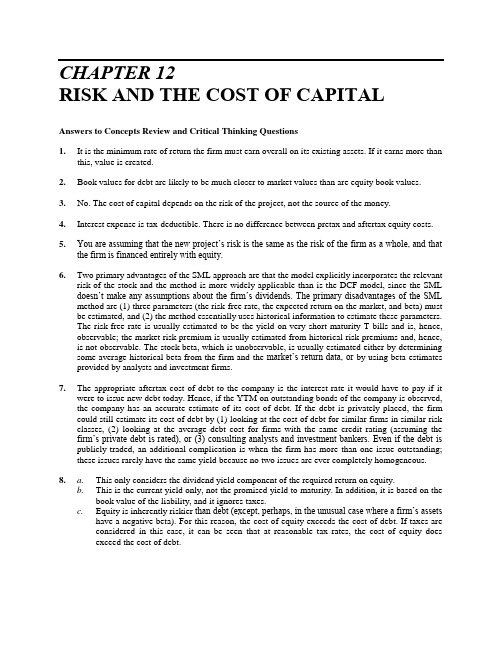
CHAPTER 12RISK AND THE COST OF CAPITALAnswers to Concepts Review and Critical Thinking Questions1.It is the minimum rate of return the firm must earn overall on its existing assets. If it earns more thanthis, value is created.2.Book values for debt are likely to be much closer to market values than are equity book values.3.No. The cost of capital depends on the risk of the project, not the source of the money.4.Interest expense is tax-deductible. There is no difference between pretax and aftertax equity costs.5.You are assuming that the new project’s risk is the same as the risk of the firm as a whole, and thatthe firm is financed entirely with equity.6.Two primary advantages of the SML approach are that the model explicitly incorporates the relevantrisk of the stock and the method is more widely applicable than is the DCF model, since the SML doesn’t make any assumptions about the firm’s dividends. The primary disadvantages of the SML method are (1) three parameters (the risk-free rate, the expected return on the market, and beta) must be estimated, and (2) the method essentially uses historical information to estimate these parameters.The risk-free rate is usually estimated to be the yield on very short maturity T-bills and is, hence, observable; the market risk premium is usually estimated from historical risk premiums and, hence, is not observable. The stock beta, which is unobservable, is usually estimated either by determining some average historical beta from the firm and the market’s return data, or by using beta estimates provided by analysts and investment firms.7.The appropriate aftertax cost of debt to the company is the interest rate it would have to pay if itwere to issue new debt today. Hence, if the YTM on outstanding bonds of the company is observed, the company has an accurate estimate of its cost of debt. If the debt is privately-placed, the firm could still estimate its cost of debt by (1) looking at the cost of debt for similar firms in similar risk classes, (2) looking at the average debt cost for firms with the same credit rating (assuming the firm’s private debt is rated), or (3) consulting analysts and investment bankers. Even if the debt is publicly traded, an additional complication is when the firm has more than one issue outstanding;these issues rarely have the same yield because no two issues are ever completely homogeneous.8. a.This only considers the dividend yield component of the required return on equity.b.This is the current yield only, not the promised yield to maturity. In addition, it is based on thebook value of the liability, and it ignores taxes.c.Equity is inherently riskier than debt (except, perhaps, in the unusual case where a firm’s assetshave a negative beta). For this reason, the cost of equity exceeds the cost of debt. If taxes are considered in this case, it can be seen that at reasonable tax rates, the cost of equity does exceed the cost of debt.B-2 SOLUTIONS= .12 + .75(.08) = .1800 or 18.00%9.RSupBoth should proceed. The appropriate discount rate does not depend on which company is investing;it depends on the risk of the project. Since Superior is in the business, it is closer to a pure play.Therefore, its cost of capital should be used. With an 18% cost of capital, the project has an NPV of $1 million regardless of who takes it.10.If the different operating divisions were in much different risk classes, then separate cost of capitalfigures should be used for the different divisions; the use of a single, overall cost of capital would be inappropriate. If the single hurdle rate were used, riskier divisions would tend to receive more funds for investment projects, since their return would exceed the hurdle rate despite the fact that they may actually plot below the SML and, hence, be unprofitable projects on a risk-adjusted basis. The typical problem encountered in estimating the cost of capital for a division is that it rarely has its own securities traded on the market, so it is difficult to observe the market’s valuation of the risk of the division. Two typical ways around this are to use a pure play proxy for the division, or to use subjective adjustments of the overall firm hurdle rate based on the perceived risk of the division.11.The discount rate for the projects should be lower that the rate implied by the security market line.The security market line is used to calculate the cost of equity. The appropriate discount rate for projects is the firm’s weighted average cost of capital. Since the firm’s cost of debt is generally less that the firm’s cost of equity, the rate implied by the security market line will be too high.12.Beta measures the responsiveness of a security's returns to movements in the market. Beta isdetermined by the cyclicality of a firm's revenues. This cyclicality is magnified by the firm's operating and financial leverage. The following three factors will impact the firm’s beta. (1) Revenues. The cyclicality of a firm's sales is an important factor in determining beta. In general, stock prices will rise when the economy expands and will fall when the economy contracts. As we said above, beta measures the responsiveness of a security's returns to movements in the market.Therefore, firms whose revenues are more responsive to movements in the economy will generally have higher betas than firms with less-cyclical revenues. (2) Operating leverage. Operating leverage is the percentage change in earnings before interest and taxes (EBIT) for a percentage change in sales. A firm with high operating leverage will have greater fluctuations in EBIT for a change in sales than a firm with low operating leverage. In this way, operating leverage magnifies the cyclicality of a firm's revenues, leading to a high beta. (3) Financial leverage. Financial leverage arises from the use of debt in the firm's capital structure. A levered firm must make fixed interest payments regardless of its revenues. The effect of financial leverage on beta is analogous to the effect of operating leverage on beta. Fixed interest payments cause the percentage change in net income to be greater than the percentage change in EBIT, magnifying the cyclicality of a firm's revenues. Thus, returns on highly-levered stocks should be more responsive to movements in the market than the returns on stocks with little or no debt in their capital structure.CHAPTER 12 B-3 Solutions to Questions and ProblemsNOTE: All end-of-chapter problems were solved using a spreadsheet. Many problems require multiple steps. Due to space and readability constraints, when these intermediate steps are included in this solutions manual, rounding may appear to have occurred. However, the final answer for each problem is found without rounding during any step in the problem.Basic1. With the information given, we can find the cost of equity using the CAPM. The cost of equity is:R E = .05 + 1.30 (.12 – .05) = .1410 or 14.10%2. The pretax cost of debt is the YTM of the company’s bonds, so:P0 = $1,050 = $40(PVIFA R%,24) + $1,000(PVIF R%,24)R = 3.683%YTM = 2 × 3.683% = 7.37%And the aftertax cost of debt is:R D = .0737(1 – .40) = .0442 or 4.42%3. a.The pretax cost of debt is the YTM of the company’s bonds, so:P0 = $1,080 = $50(PVIFA R%,46) + $1,000(PVIF R%,46)R = 4.58%YTM = 2 × 4.58% = 9.16%b.The aftertax cost of debt is:R D = .0916(1 – .40) = .05496 or 5.50%c.The aftertax rate is more relevant because that is the actual cost to the company.4. The book value of debt is the total par value of all outstanding debt, so:BV D = €20M + 80M = €100MTo find the market value of debt, we find the price of the bonds and multiply by the number of bonds. Alternatively, we can multiply the price quote of the bond times the par value of the bonds.Doing so, we find:MV D = 1.08(€20M) + .58(€80M) = €68MB-4 SOLUTIONSThe YTM of the zero coupon bonds is:P Z = €580 = €1,000(PVIF R%,7)R = 8.09%So, the aftertax cost of the zero coupon bonds is:R Z = .0809(1 – .35) = .0526 or 5.26%The aftertax cost of debt for the company is the weighted average of the aftertax cost of debt for all outstanding bond issues. We need to use the market value weights of the bonds. The total aftertax cost of debt for the company is:R D = .0595(€21.6/€68) + .0526(€46.4/€68) = .0548 or 5.48%5. Using the equation to calculate the WACC, we find:WACC = .60 (.16) + .40(.09)(1 – .35) = .1194 or 11.94%6. Here we need to use the debt-equity ratio to calculate the WACC. Doing so, we find:WACC = .18(1/1.60) + .10(.60/1.60)(1 – .35) = .1369 or 13.69%7.Here we have the WACC and need to find the debt-equity ratio of the company. Setting up theWACC equation, we find:WACC = .1150 = .16(E/V) + .075(D/V)(1 – .35)Rearranging the equation, we find:.115(V/E) = .16 + .075(.65)(D/E)Now we must realize that the V/E is just the equity multiplier, which is equal to:V/E = 1 + D/E.115(D/E + 1) = .16 + .04875(D/E)Now we can solve for D/E as:.06625(D/E) = .0450D/E = .6792CHAPTER 12 B-5 8. a.The book value of equity is the book value per share times the number of shares, and the bookvalue of debt is the face value of the company’s debt, so:BV E = 9.5M(£5) = £47.5MBV D = £75M + 60M = £135MSo, the total value of the company is:V = £47.5M + 135M = £182.5MAnd the book value weights of equity and debt are:E/V = £47.5/£182.5 = .2603D/V = 1 – E/V = .7397b.The market value of equity is the share price times the number of shares, so:MV E = 9.5M(£53) = £503.5MUsing the relationship that the total market value of debt is the price quote times the par value of the bond, we find the market value of debt is:MV D = .93(£75M) + .965(£60M) = £127.65MThis makes the total market value of the company:V = £503.5 + 127.65M = £631.15And the market value weights of equity and debt are:E/V = £503.5/£631.15 = .7978D/V = 1 – E/V = .2022c.The market value weights are more relevant.B-6 SOLUTIONS9.First, we will find the cost of equity for the company. The information provided allows us to solvefor the cost of equity using the CAPM, so:R E = .052 + 1.2(.09) = .1600 or 16.00%Next, we need to find the YTM on both bond issues. Doing so, we find:P1 = $930 = $40(PVIFA R%,20) + $1,000(PVIF R%,20)R = 4.54%YTM = 4.54% × 2 = 9.08%P2 = $965 = $37.5(PVIFA R%,12) + $1,000(PVIF R%,12)R = 4.13%YTM = 4.13% × 2 = 8.25%To find the weighted average aftertax cost of debt, we need the weight of each bond as a percentage of the total debt. We find:w D1 = .93($75M)/$127.65M = .546w D2 = .965($60M)/$127.65M = .454Now we can multiply the weighted average cost of debt times one minus the tax rate to find the weighted average aftertax cost of debt. This gives us:R D = (1 – .40)[(.546)(.0908) + (.454)(.0825)] = .0522 or 5.22%Using these costs and the weight of debt we calculated earlier, the WACC is:WACC = .7978(.1600) + .2022(.0522) = .1382 or 13.82%10. ing the equation to calculate WACC, we find:WACC = .105 = (1/1.8)(.15) + (.8/1.8)(1 – .35)R DR D = .0750 or 7.50%ing the equation to calculate WACC, we find:WACC = .105 = (1/1.8)R E + (.8/1.8)(.062)R E = .1394 or 13.94%CHAPTER 12 B-7 11.We will begin by finding the market value of each type of financing. We find:MV D = 4,000($1,000)(1.03) = $4,120,000MV E = 90,000($57) = $5,130,000And the total market value of the firm is:V = $4,120,000 + 5,130,000 = $9,250,000Now, we can find the cost of equity using the CAPM. The cost of equity is:R E = .06 + 1.10(.08) = .1480 or 14.80%The cost of debt is the YTM of the bonds, so:P0 = $1,030 = $35(PVIFA R%,40) + $1,000(PVIF R%,40)R = 3.36%YTM = 3.36% × 2 = 6.72%And the aftertax cost of debt is:R D = (1 – .35)(.0672) = .0437 or 4.37%Now we have all of the components to calculate the WACC. The WACC is:WACC = .0437(4.12/9.25) + .1480(5.13/9.25) = .1015 or 10.15%Notice that we didn’t include the (1 – t C) term in the WACC equation. We simply used the aftertax cost of debt in the equation, so the term is not needed here.12. a.We will begin by finding the market value of each type of financing. We find:MV D = 120,000(元1,000)(0.93) = 元111,600,000MV E = 9,000,000(元34) = 元306,000,000And the total market value of the firm is:V = 元111,600,000 + 306,000,000 = 元417,600,000So, the market value weights of the comp any’s financing is:D/V = 元111,600,000/元417,600,000 = .2672E/V = 元111,600,000/元417,600,000 = .7328B-8 SOLUTIONSb.For projects equally as risky as the firm itself, the WACC should be used as the discount rate.First we can find the cost of equity using the CAPM. The cost of equity is:R E = .05 + 1.20(.10) = .1700 or 17.00%The cost of debt is the YTM of the bonds, so:P0 = 元930 = 元42.5(PVIFA R%,30) + 元1,000(PVIF R%,30)R = 4.69%YTM = 4.69% × 2 = 9.38%And the aftertax cost of debt is:R D = (1 – .35)(.0938) = .0610 or 6.10%Now we can calculate the WACC as:WACC = .1700(.7328) + .0610 (.2672) = .1409 or 14.09%13. a.Projects X, Y and Z.ing the CAPM to consider the projects, we need to calculate the expected return of eachproject given its level of risk. This expected return should then be compared to the expected return of the project. If the return calculated using the CAPM is higher than the project expected return, we should accept the project; if not, we reject the project. After considering risk via the CAPM:E[W] = .05 + .60(.12 – .05) = .0920 < .11, so accept WE[X] = .05 + .90(.12 – .05) = .1130 < .13, so accept XE[Y] = .05 + 1.20(.12 – .05) = .1340 < .14, so accept YE[Z] = .05 + 1.70(.12 – .05) = .1690 > .16, so reject Zc. Project W would be incorrectly rejected; Project Z would be incorrectly accepted.Intermediateing the debt-equity ratio to calculate the WACC, we find:WACC = (.65/1.65)(.055) + (1/1.65)(.15) = .1126 or 11.26%Since the project is riskier than the company, we need to adjust the project discount rate for the additional risk. Using the subjective risk factor given, we find:Project discount rate = 11.26% + 2.00% = 13.26%CHAPTER 12 B-9We would accept the project if the NPV is positive. The NPV is the PV of the cash outflows plus the PV of the cash inflows. Since we have the costs, we just need to find the PV of inflows. The cash inflows are a growing perpetuity. If you remember, the equation for the PV of a growing perpetuity is the same as the dividend growth equation, so:PV of future CF = $3,500,000/(.1326 – .05) = $42,385,321The project should only be undertaken if its cost is less than $42,385,321 since costs less than this amount will result in a positive NPV.15.We will begin by finding the market value of each type of financing. We will use D1 to representthe coupon bond, and D2 to represent the zero coupon bond. So, the market value of the firm’s financing is:MV D1 = 50,000(¥1,000)(1.1980) = ¥59,900,000MV D2 = 150,000(¥1,000)(.1385) = ¥20,775,000MV P = 120,000(¥112) = ¥13,440,000MV E = 2,000,000(¥65) = ¥130,000,000And the total market value of the firm is:V = ¥59,900,000 + 20,775,000 + 13,440,000 + 130,000,000 = ¥224,115,000Now, we can find the cost of equity using the CAPM. The cost of equity is:R E = .04 + 1.10(.09) = .1390 or 13.90%The cost of debt is the YTM of the bonds, so:P0 = ¥1,198 = ¥40(PVIFA R%,50) + ¥1,000(PVIF R%,50)R = 3.20%YTM = 3.20% × 2 = 6.40%And the aftertax cost of debt is:R D2 = (1 – .40)(.0640) = .0384 or 3.84%And the aftertax cost of the zero coupon bonds is:P0 = ¥138.50 = ¥1,000(PVIF R%,60)R = 3.35%YTM = 3.35% × 2 = 6.70%R D1 = (1 – .40)(.0670) = .0402 or 4.02%Even though the zero coupon bonds make no payments, the calculation for the YTM (or price) still assumes semiannual compounding, consistent with a coupon bond. Also remember that, even though the company does not make interest payments, the accrued interest is still tax deductible for the company.B-10 SOLUTIONSTo find the required return on preferred stock, we can use the preferred stock pricing equation, which is the level perpetuity equation, so the required return on the company’s preferred stock is: R P = D1 / P0R P = ¥6.50 / ¥112R P = .0580 or 5.80%Notice that the required return in the preferred stock is lower than the required on the bonds. This result is not consistent with the risk levels of the two instruments, but is a common occurrence.There is a practical reason for this: Assume Company A owns stock in Company B. The tax code allows Company A to exclude at least 70 percent of the dividends received from Company B, meaning Company A does not pay taxes on this amount. In practice, much of the outstanding preferred stock is owned by other companies, who are willing to take the lower return since it is effectively tax exempt.Now we have all of the components to calculate the WACC. The WACC is:WACC = .0684(59.9/224.115) + .0402(20.775/224.115) + .1390(130/224.115)+ .0580(13.44/224.115)WACC = .0981 or 9.81%Challenge16.We can use the debt-equity ratio to calculate the weights of equity and debt. The debt of thecompany has a weight for long-term debt and a weight for accounts payable. We can use the weight given for accounts payable to calculate the weight of accounts payable and the weight of long-term debt. The weight of each will be:Accounts payable weight = .20/1.20 = .17Long-term debt weight = 1/1.20 = .83Since the accounts payable has the same cost as the overall WACC, we can write the equation for the WACC as:WACC = (1/2.3)(.17) + (1.3/2.3)[(.20/1.2)WACC + (1/1.2)(.09)(1 – .35)]Solving for WACC, we find:WACC = .0739 + .5652[(.20/1.2)WACC + .0488]WACC = .0739 + (.0942)WACC + .0276(.9058)WACC = .1015WACC = .1132 or 11.32%Since the cash flows go to perpetuity, we can calculate the future cash inflows using the equation for the PV of a perpetuity. The NPV is:NPV = –$45,000,000 + ($5,700,000/.1132)NPV = –$45,000,000 + 50,372,552 = $5,372,552CHAPTER 12 B-11 17.The €4 million cost of the land 3 years ago is a sunk cost and irrelevant; the €6.5 million appraisedvalue of the land is an opportunity cost and is relevant. The relevant market value capitalization weights are:MV D = 15,000(€1,000)(0.92) = €13,800,000MV E = 300,000(€75) = €22,500,000MV P = 20,000(€72) = €1,440,000The total market value of the company is:V = €13,800,000 + 22,500,000 + 1,440,000 = €37,740,000Next we need to find the cost of funds. We have the information available to calculate the cost of equity using the CAPM, so:R E = .05 + 1.3(.08) = .1540 or 15.40%The cost of debt is the YTM of the company’s outstanding bonds, so:P0 = €920 = €35(PVIFA R%,30) + €1,000(PVIF R%,30)R = 3.96%YTM = 3.96% × 2 = 7.92%And the aftertax cost of debt is:R D = (1 – .35)(.0792) = .0515 or 5.15%The cost of preferred stock is:R P = €5/€72 = .0694 or 6.94%a.The initial cost to the company will be the opportunity cost of the land, the cost of the plant,and the net working capital cash flow, so:CF0 = –€6,500,000 – 15,000,000 – 900,000 = –€22,400,000b.To find the required return on this project, we first need to calculate the WACC for thecompany. The company’s WACC is:WACC = [(€22.5/€37.74)(.1540) + (€1.44/€37.74)(.0694) + (€13.8/€37.74)(.0515)] = .1133The company wants to use the subjective approach to this project because it is located overseas.The adjustment factor is 2 percent, so the required return on this project is:Project required return = .1133 + .02 = .1333B-12 SOLUTIONSc.The annual depreciation for the equipment will be:€15,000,000/8 = €1,875,000So, the book value of the equipment at the end of five years will be:BV5 = €15,000,000 – 5(€1,875,000) = €5,625,000So, the aftertax salvage value will be:Aftertax salvage value = €5,000,000 + .35(€5,625,000 – 5,000,000) = €5,218,750ing the tax shield approach, the OCF for this project is:OCF = [(P – v)Q – FC](1 – t) + t C DOCF = [(€10,000 – 9,000)(12,000) – 400,000](1 – .35) + .35(€15M/8) = €8,196,250e.The accounting breakeven sales figure for this project is:Q A = (FC + D)/(P – v) = (€400,000 + 1,875,000)/(€10,000 – 9,000) = 2,275 unitsf.We have calculated all cash flows of the project. We just need to make sure that in Year 5 weadd back the aftertax salvage value, the recovery of the initial NWC, and the aftertax value of the land. The cash flows for the project are:Year Flow Cash0 –€22,400,0001 8,196,2502 8,196,2503 8,196,2504 8,196,2505 18,815,000Using the required return of 13.33 percent, the NPV of the project is:NPV = –€22,400,000 + €8,196,250(PVIFA13.33%,4) + €18,815,000/1.13335NPV = €11,878,610.78And the IRR is:NPV = 0 = –€22,400,000 + €8,196,250(PVIFA IRR%,4) + €18,815,000/(1 + IRR)5IRR = 30.87%。
公司理财(罗斯)第2章(英文)
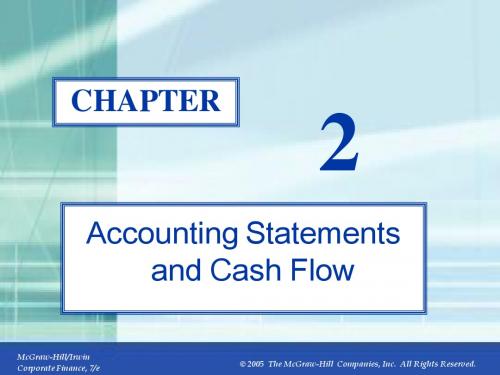
2-2
Sources of Information
Annual reports Wall Street Journal Internet
2.1 The Balance Sheet 2.2 The Income Statement 2.3 Net Working Capital 2.4 Financial Cash Flow 2.5 The Statement of Cash Flows 2.6 Financial Statement Analysis 2.7 Summary and Conclusions
McGraw-Hill/Irwin Corporate Finance, 7/e 2005 The McGraw-Hill Companies, Inc. All Rights Reserved.
2-6
Debt versus Equity
Generally, when a firm borrows it gives the bondholders first claim on the firm’s cash flow. Thus shareholder’s equity is the residual difference between assets and liabilities.
Total assets
McGraw-Hill/Irwin Corporate Finance, 7/e
$1,879
$1,742
2005 The McGraw-Hill Companies, Inc. All Rights Reserved.
个人理财英文版二PPT课件

Money Management Skills
McGraw-Hill/Irwin
Copyright © 2010 by The McGraw-Hill Companies, Inc. All rights reserved.
Money Management Skills
Chapter Objectives
• Daily spending and saving decisions = central to financial planning
– Must be coordinated with needs, goals, and personal situations
2-3
Components of Money Management
preparation software • Account summaries and investment
performance results • Computerized versions of wills,
estate plans, and other documents
* Keep a backup!
2-5
An Organized Personal Financial Records System
Provides a basis for:
• Handling daily business affairs, such as bill paying
• Planning and measuring financial progress
• Items you refer to often
– Personal and employment records – Money management records – Tax records – Financial services records – Credit records – Consumer purchase and auto records – Housing records – Insurance records – Investment records – Estate planning and retirement records
公司理财原版英文课件Chap023

We plan to sell 25 meal plans at $200 per month with a 12-month contract. Variable costs are projected to be $3,500 per month. Fixed costs (lease payment) are projected to be $1,500 per month. We can depreciate our capitalized leaseholder improvements.
σ2 ln( S / E ) ( R )t 2 d1 t
N(d) = Probability that a standardized, normally distributed, random variable will be less than or equal to d.
23-8
23-5
Campusteria Pro Forma Income Statement
Investment Revenues Variable Costs Fixed Costs Depreciation Pretax profit Tax shield 34% Net Profit Cash Flow Year 0 Years 1-4 $60,000 ($42,000) ($18,000) ($7,500) ($7,500) $2,550 ($4,950) $2,550
-$30,000
NPV $30,000
t 1
$2,550 $21,916.84 t 23-6 (1.10)
Valuing a Start-Up
Note that while the Campusteria test site has a negative NPV, we are close to our break-even level of sales. If we expand, we project opening 20 Campusterias in year four. The value of the project is in the option to expand. We will use the Black-Scholes option pricing model to value this option.
